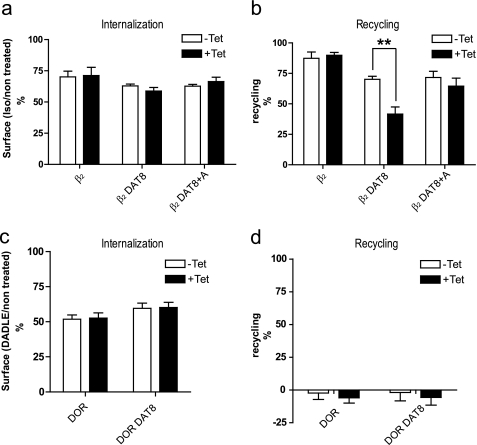FIGURE 6.
PICK1 impairs recycling of agonist-internalized β2DAT8 but not DOR DAT8, which sorts to degradation. a and b, flp-In T-REx 293 eYFP-PICK1 cells transiently expressing β2, β2DAT8, or β2DAT8 +Ala with (black bars; +Tet) and without (white bars; −Tet) tetracycline-induced expression of eYFP-PICK1 were surface-labeled with anti-FLAG M1 antibody prior to stimulation of internalization with agonist (10 μm Iso for 25 min). Subsequently, cells were treated with the antagonist Alp (60 min at 10 μm) to allow recycling. Surface receptor immunoreactivity was determined by surface ELISA as described under “Experimental Procedures.” Internalization (a) refers to the fractional reduction of surface receptor in response to 25 min of agonist exposure compared with non-treated cells. Recycling (b) refers to the fractional recovery of surface receptor following antagonist incubation for 1 h. Data represent means ± S.E. from four independent experiments. c and d, Flp-In T-REx 293 eYFP-PICK1 cells transiently expressing DOR or DOR DAT8 with (black bars; +Tet) and without (white bars; −Tet) tetracycline-induced expression of eYFP-PICK1 were surface-labeled with anti-FLAG M1 antibody prior to stimulation of internalization with 10 μm δ-opioid receptor agonist peptide DADLE for 25 min followed by a 60-min incubation with 10 μm antagonist Naxo to allow potential recycling of receptors. Surface receptor immunoreactivity was determined by surface ELISA as described under “Experimental Procedures.” Internalization (c) refers to the fractional reduction of surface receptor in response to 25 min of agonist exposure compared with non-treated cells. Recycling (d) refers to the fractional recovery of surface receptor following antagonist incubation for 1 h. Data represent means ± S.E. from four independent experiments. **, p < 0.01, unpaired t test.

